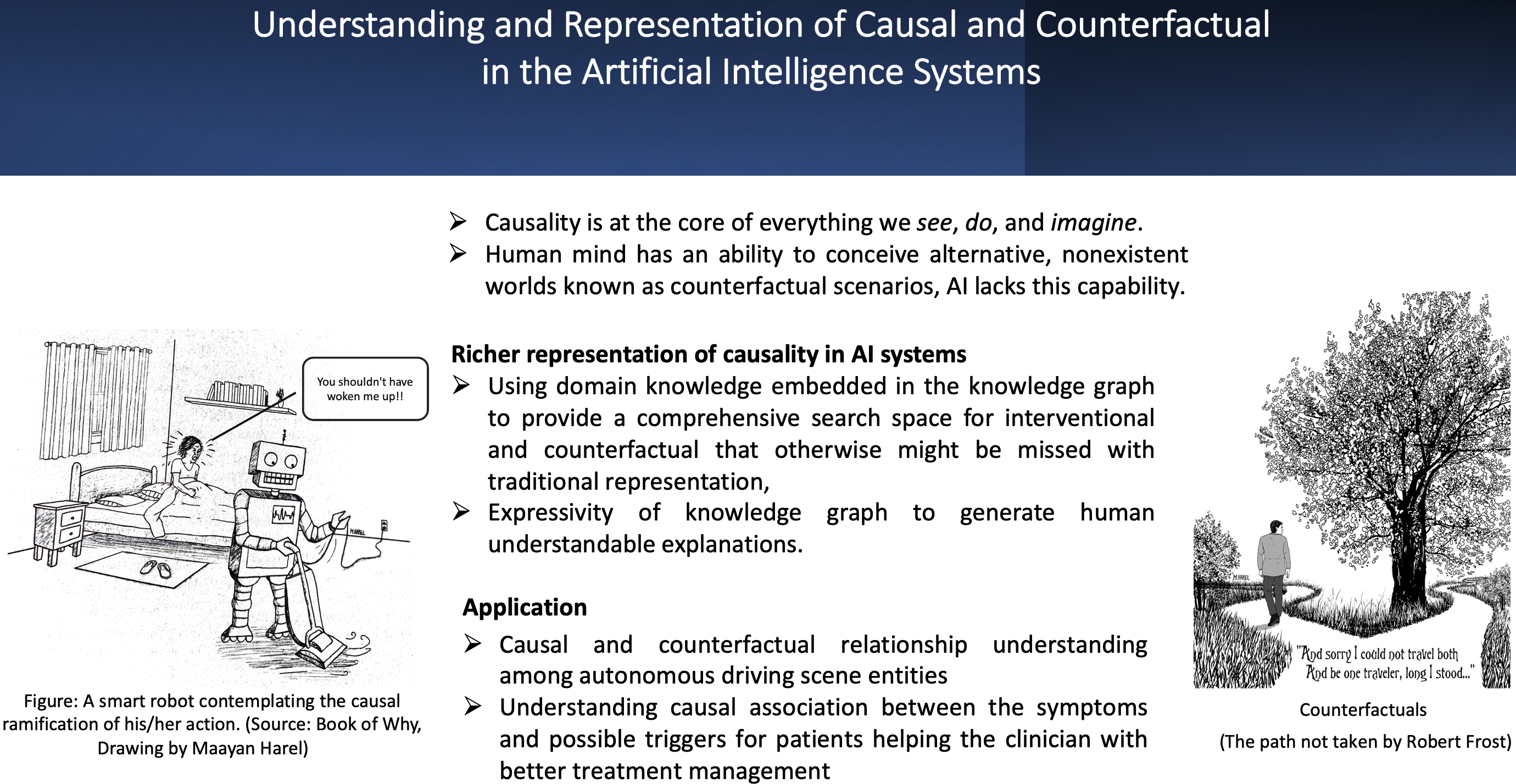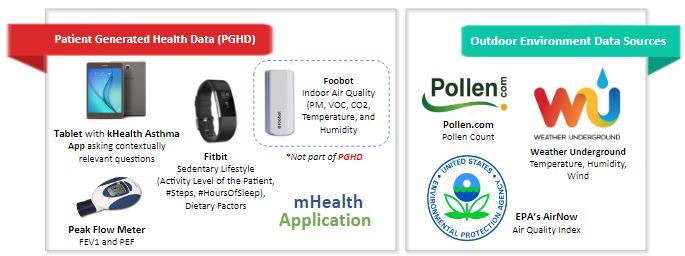
Causal Neuro-symbolic AI: Casual Representation and Explainability in knowledge graph
The artificial intelligence (AI) systems do not incorporate high-level reasoning and understanding about causality. As a result, the systems do not form the kinds of semantic representations and inferences that humans can. Enriching the AI systems to incorporate causality enabled with counterfactual reasoning is a challenging task due to a lack of richer causality representation. My research focuses on developing, CausalKG, a richer representation for causality using knowledge graphs for better explainability with autonomous driving and healthcare applications. CausalKG can infuse existing KGs with causal knowledge of the domain to enable interventional and counterfactual reasoning. The advantage of constructing a CausalKG is the integration of causality in reasoning and prediction processes, such as the agent action understanding, planning, medical diagnosis process, etc. Such integration can improve the accuracy and reliability of existing AI algorithms by providing better causal and domain adaptable explainability of the outcome.
- Causal Neuro-Symbolic AI: A Synergy Between Causality and Neuro-Symbolic Methods
Causal Neuro-Symbolic AI combines the benefits of causality with Neuro-Symbolic Artificial Intelligence(NeSyAI). More specifically, it (1) enriches NeSyAI systems with explicit representations of causality,(2) integrates causal knowledge with domain knowledge, and (3) enables the use of NeSyAI techniques for causal AI tasks. The explicit causal representation yields insights that predictive models may fail to analyze from observational data. It can also assist people in decision-making scenarios where discerning the cause of an outcome is necessary to choose among various interventions.
- CausalKG: Causal Knowledge Graph Explainability using interventional and counterfactual reasoning
Humans use causality and hypothetical retrospection in their daily decision-making, planning, and understanding of life events. The human mind, while retrospecting a given situation, think about questions such as “What was the cause of the given situation?,” “What would be the effect of my action?,” “What would have happened if I had taken another action instead?,” or “Which action led to this effect?” The human mind has an innate understanding of causality. It develops a causal model of the world, which learns with fewer data points, makes inferences, and contemplates counterfactual scenarios.8 The unseen and unknown scenarios are called “counterfactuals.”
- CausalLP: Learning causal relations with weighted knowledge graph link prediction
Causal networks play an important role in many practical applications, ranging from medical diagnosis to root-cause analysis in manufacturing. In real-world settings, these networks often suffer from incompleteness due to missing causal links. This paper presents a novel approach, CausalLP, which addresses this issue by formulating the problem of incomplete causal networks as a knowledge graph completion problem. More specifically, knowledge graph link prediction methods are utilized to find missing links in the incomplete causal network. In addition, the causal links are annotated with weights that represent the strength of the causal link between entities. Two distinct dataset splitting approaches are used for evaluation: (1) random-based split, which is the method typically employed to evaluate link prediction algorithms, and (2) Markov-based split, a novel data split technique that utilizes the Markovian property of causal relations. An evaluation of the proposed approach uses a causal benchmark dataset and compares the performance of multiple knowledge graph em- bedding algorithms. Results show that using weighted causal links outperforms the baseline by an average of 112.03% (mean reciprocal rank).
- Influence of Backdoor Paths on Causal Link Prediction
The current method for predicting causal links in knowledge graphs uses weighted causal relations. For a given link between cause-effect entities, the presence of a confounder affects the causal link prediction, which can lead to spurious and inaccurate results. We aim to block these confounders using backdoor path adjustment. Backdoor paths are non-causal association flows that connect the cause-entity to the effect-entity through other variables. Removing these paths ensures a more accurate prediction of causal links. This paper proposes CausalLPBack, a novel approach to causal link prediction that eliminates backdoor paths and uses knowledge graph link prediction methods. It extends the representation of causality in a neuro-symbolic framework, enabling the adoption and use of traditional causal AI concepts and methods. We demonstrate our approach using a causal reasoning benchmark dataset of simulated videos. The evaluation involves a unique dataset splitting method called the Markov-based split that's relevant for causal link prediction. The evaluation of the proposed approach demonstrates atleast 30% in MRR and 16% in Hits@K inflated performance for causal link prediction that is due to the bias introduced by backdoor paths for both baseline and weighted causal relations.
- HyperCausalLP: Causal Link Prediction using Hyper-Relational Knowledge Graph
Causal networks are often incomplete with missing causal links. This is due to various issues, such as missing observation data. Recent approaches to the issue of incomplete causal networks have used knowledge graph link prediction methods to find the missing links. In the causal link A causes B causes C, the influence of A to C is influenced by B which is known as a mediator. Existing approaches using knowledge graph link prediction do not consider these mediated causal links. This paper presents HyperCausalLP, an approach designed to find missing causal links within a causal network with the help of mediator links. The problem of missing links is formulated as a hyper-relational knowledge graph completion. The approach uses a knowledge graph link prediction model trained on a hyper-relational knowledge graph with the mediators. The approach is evaluated on a causal benchmark dataset, CLEVRER-Humans. Results show that the inclusion of knowledge about mediators in causal link prediction using hyper-relational knowledge graph improves the performance on an average by 5.94% mean reciprocal rank.
- Visual Causal Question and Answering with Knowledge Graph Link Prediction
The ability to answer causal questions is important for any system that requires robust scene under-standing. In this demonstration, we develop a prototype system that leverages our causal link prediction framework, CausalLP. CausalLP framework uses a visual causal knowledge graph and associated knowledge graph embedding for two visual causal question and answering tasks-(i) causal explanation and (ii) causal prediction. In the live demonstration sessions, the participants will be invited to test the efficiency and effectiveness of the system for visual causal question and answering.
- Causal Knowledge Graph for Scene Understanding in Autonomous Driving
The current approaches to autonomous driving focus on learning from observation or simulated data. These approaches are based on correlations rather than causation. For safety-critical applications, like autonomous driving, it’s important to represent causal dependencies among variables in addition to the domain knowledge expressed in a knowledge graph. This will allow for a better understanding of causation during scenarios that have not been observed, such as malfunctions or accidents. The causal knowledge graph, coupled with domain knowledge, demonstrates how autonomous driving scenes can be represented, learned, and explained using counterfactual and intervention reasoning to infer and understand the behavior of entities in the scene.
- Causal Neuro-Symbolic AI for Root Cause Analysis in Smart Manufacturing
Root cause analysis is the process of investigating the cause of a failure and providing measures to prevent future failures. It is an active area of research due to the complexities in manufacturing production lines and the vast amount of data that requires manual inspection. We present a combined approach of causal neuro-symbolic AI for root cause analysis to identify failures in smart manufacturing production lines. We have used data from an industry-grade rocket assembly line and a simulation package to demonstrate the effectiveness and relevance of our approach.

kHealth
Knowledge-enabled health care (kHealth) is an interdisciplinary project to help doctors determine precisely the cause, severity and control of asthma. It aims to alert patient/caregiver to seek clinical assistance in timely manner to better manage asthma and improve their quality of life. The project includes real-world evaluations (i.e. 200 children with asthma) to measure the effectiveness of the approach. It uses patient generated health data (PGHD) via mobile and sensor technologies. kHealth supports the AI-based reasoning approach of semantic cognitive perceptual computing and augmented personalized health (APH). kHealth research encompasses multiple funded projects, the most recent one being "SCH: kHealth: Semantic Multi-sensory Mobile Approach to Personalized Asthma Care", which was funded by the National Institutes of Health in 2016.
Team: Utkarshani Jaimini, Revathy Venkatraman, Joey Yip, Vaikunth Sridharan, Dipesh Kadaria, Quintin Oliver- Contextual Multi-arm bandits for Personalized Treatment Recommendation
Timely Treatment Recommendation can lead to better health outcome, reduce healthcare cost, and improved quality of health in pediatric patients. Develop a Treatment Recommendation system using Contextual multi-arm bandits to improve the patient health state of the pediatric asthma patients. Determine the contextual features of a patient which are most efficient for predicting patient’s health status. Explore the offline contextual bandit estimators for learning and propose a general framework for learning algorithms.
- Personalized Causal Model and Dynamic Treatment Regimes for Pediatric Asthma Patients
A Causal Model to determine the causal relationship between asthma symptoms, medication intake and asthma triggers in the pediatric asthma patient population. Evaluate the efficacy of treatment policies via counterfactual variable on the patient’s health state using the total, natural direct, and natural indirect effect estimation.
- Personalized Bayesian Inference and Prediction Model
A personalized knowledge-based Bayesian inference model to predict symptoms for different outdoor environmental factors utilizing the real-world knowledge from the pediatric asthma patient’s data collected from continuous monitoring framework: kHealth-Asthma. Analyzed multimodal data for correlation between the asthma symptoms and various asthma triggers.
- Health Coefficient for environmental susceptibility detection
A Health Coefficient metric to determine the health of the pediatric asthma patient with the onset of the outdoor environmental triggers. Utilizing the prediction from the personalized Bayesian inference model, performed Weibull analysis to discern the susceptibility level of a patient to various outdoor environmental triggers.
- Digital Phenotype Score for Pediatric Asthma Patients
A Digital Phenotype score (DPS) as an abstraction of the multimodal digital phenotypes collected using the sensors and mobile applications. The DPS is clinically relevant to the Asthma Control Test (ACT) score taken at the clinic. The DPS provides an opportunity for early clinical intervention by the healthcare provider, leading to better management, and monitoring of asthma.
- Activity detection using an Indoor Air Quality Sensor for Asthma Management in Children
Data-driven approach to develop a continuous monitoring-activity (such as cooking and smoking) detection system aimed at understanding and improving indoor air quality in asthma management. High concentration of particulate matter, volatile organic compounds, and carbon dioxide was detected during cooking and smoking activities. The activity detection system can allow clinicians to correlate potential asthma symptoms and exacerbation reports from patients with environmental factors without having to personally be present
- Integration of multimodal data for Asthma Management using kHealth Asthma Ontology (kAO)
Explored the use of semantic web technologies for the integration of multimodal data collected from the continuous monitoring of pediatric asthma patients with the kHealth Asthma Ontology. Improved the existing BioPortal Asthma Ontology to add meaningful relationship information between the ontology concepts. The queries demonstrated that the data integration enabled us to extract useful information and performed hypothesis validation across different data modality.
Gender based context analysis of textual data
Analyzed the Wikipedia page text to determine the use of gender specific language using Naïve Bayes and Natural Language Processing techniques. The proposed work can serve as a pre-cursor in monitoring and moderating abusive language online by providing the gender context.